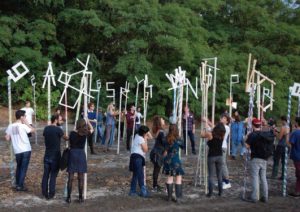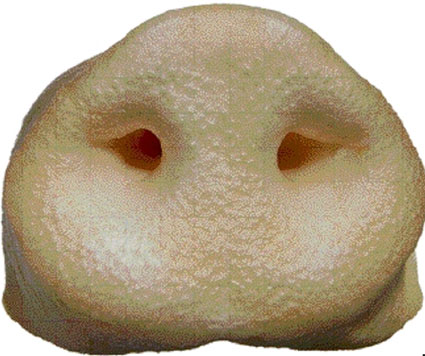 Christien Meindertsma is a designer with an investigative mind. She analyzes, surveys and in her latest project she went as far as dissecting a pig.
Christien Meindertsma is a designer with an investigative mind. She analyzes, surveys and in her latest project she went as far as dissecting a pig.
A few years ago, as she was graduating from the Design Academy Eindhoven, she bought for a few euros the 3267 items taken from the passengers who embark at Schiphol airport in Amsterdam during one week: spoons, nail clippers, golf tools, bottle openers, pipe wrench, pocket knives, one axe, combs, toy pistols, etc. She photographed and archived the collection in Checked Baggage, a book containing the pictures of all these ‘tools of supposed soldiers of skyjacking and terrorism.’ The book itself was not safe for air travel as it came packaged with one of the ‘prohibited items’.
Next, Meindertsma set her sight on sheep. She used the wool of one sheep to make a sweater, a pair of socks, a scarf and a pair of gloves. She then attached to each garment the identification number of the sheep that donated the wool.
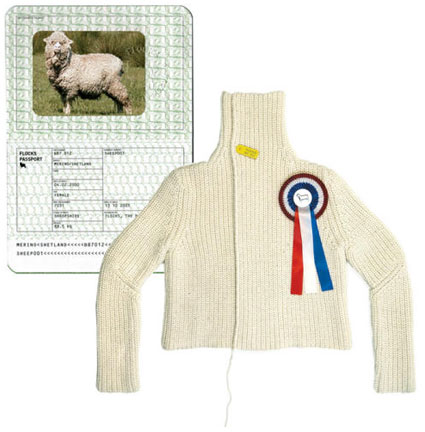 Christien Meindertsma has now filled a warehouse of pig products in the Rotterdam Kunsthal during an exhibition called Kunsthal Kookt (‘The Kunsthal cooks’). Most of these products would never grace the display of your local butcher. They are the result of her investigation on what happens to a pig after it has been slaughtered. Part of it ends up BBQ’d but what about the rest?
Christien Meindertsma has now filled a warehouse of pig products in the Rotterdam Kunsthal during an exhibition called Kunsthal Kookt (‘The Kunsthal cooks’). Most of these products would never grace the display of your local butcher. They are the result of her investigation on what happens to a pig after it has been slaughtered. Part of it ends up BBQ’d but what about the rest?
Over three years, the designer tracked the products made from parts or even tiny particles of pigs. Her quest led her to a tattoo artist, dentist, farmer and weapon specialist. She discovered that the skin, bones, meat, organs, blood, fat, brains, hoofs, hair and tail of the pig are used in no fewer than 187 products: shampoo, medicine, munitions, cardiac valves, matches, desserts and bubblegum, beer and lemonade, car paint and brake discs, pills, bread, etc.
After slaughter, bits and pieces of the Dutch pig travel around the world. Gelatin from its skin ends up in liquorices and gums, and even cheesecake and tiramisu. In the weapon industry the gelatin is used as conductor for bullets. Pork fat is one of the ingredients of, amongst others, anti-wrinkle cream and shampoo, information that producers are not too keen on admitting. The glue made from pig bones makes matches sturdier and porcelain is manufactured from its ashes. Protein from pig’s hair contributes to making bread soft. Every part of a pig is either eaten or processed. Should anything be left over, it is converted into green electric power. She documented her findings in the book PIG 05049 (amazon UK and USA).
If you understand a bit of dutch, here’s a video interview of the designer. If not, i’m afraid you’ll have to read the one we did via email:
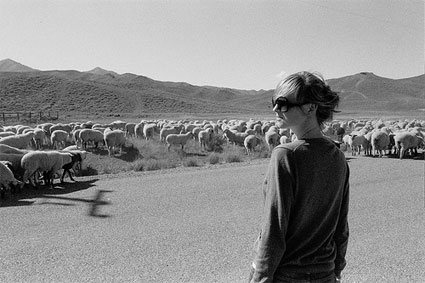 Portrait of Christien Meindertsma, courtesy of the designer
Portrait of Christien Meindertsma, courtesy of the designer
What is behind the title of your latest work, PIG 05049?
PIG 05049 is a book that shows 185 endproducts that are made of a single pig. They are catagorized under the chapters Skin, Bones, Muscles, Blood, Internal intestines, Fat and Other.
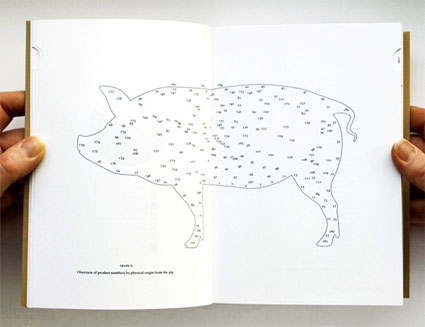 You have filled a warehouse with pig-derived products in the Rotterdam Kunsthal for an exhibition which runs until September 28. How does the public react to the shocking news that there are traces of pigs in shampoos and bubblegums? Do you find them eager to change their buying habits?
You have filled a warehouse with pig-derived products in the Rotterdam Kunsthal for an exhibition which runs until September 28. How does the public react to the shocking news that there are traces of pigs in shampoos and bubblegums? Do you find them eager to change their buying habits?
They are curious and read all the products information. I expected more shock then there actually is. It is more surprise and curiosity. It would be impossible for consumers to find out which shampoos and gum actually have traces of pigs inside. I followed one pig and found all these products at the end of the line, but that doesn’t mean that – for instance- all shampoos carry pig traces inside.
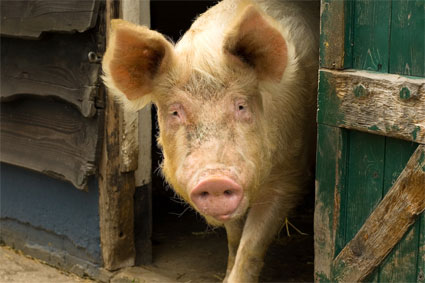 Image 100% mike
Image 100% mike
Tattoo parlor, dentist studio, workshop of a weapon specialist, etc. The research for this project led you to meet a wide range of people. Can you tell us about one of the most interesting/surprising/exciting encounter you made over those 3 years spent working on this project?
It was very interesting to find such a wide variety of products, places and people. Some were very exited about cooperating, others were very secretive. One of the most surprising products is a bullet. It is made in the USA, gelatine from the pig is used to transport gunpowder into the bullet smoothly. So the pig is not actually inside the bullet but it is used in the production process.
The strangest encounter was with a director of a company that makes heartvalves for human hearts out of pig hearts. A beautiful high- and at the same time lowtech product. He told me he didn’t want his product -pig’s heartvalves-to be associated with pigs.
Revealing the use of pig ingredients to make some beauty creams and even in some candies might jeopardize their marketing value, especially among some religious communities. How difficult was it to obtain precise information from the cosmetic and food industry about the presence of pig ingredients in their products? Did you encounter any resistance at some point?
I received most of my information from a company that is at the beginning of the chain. They make all the raw materials for producers, so they know what is made of their materials. I am very greatful for their cooperation, they were very open and sponsored me in knoledge without wanting anything back for it, which is special because their clients were not always that open.
Which lesson(s) do you hope that the public will draw from your research?
That we should know more about the products we consume and the materials they are made of. I think a simple interest in them, what they are made of, who makes it and how, would already be a great step forward.
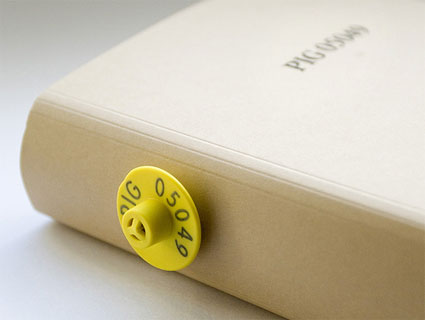 Image courtesy of the designer
Image courtesy of the designer
I like the simple design of the PIG 05049 book. What is this yellow plastic thing stuck to its cover?
That is a duplicate of the eartag of a pig with number 05049 that the book is named after.
Are you a vegetarian? Or did your relationship to food changed since you started working on this project?
As a child I used to be. I eat some meat and fish now but not so much and when I cook it myself I try to buy good eco friendly meat.
I think I became more aware of ingredients in products generally, food as well as non-food. I started realy appreciating pure products with simple ingredients as well as complex products. For me as a designer i think i learned a lot.
What happened to These Flocks? Are you still working on the project? Selling some knitted garments?
I am currently working on new knitwear for Flocks. The large scale knits like the poufs and rugs are all made by hand in the Netherlands and for the smaller more fine pieces I started working with 3d knittingmachines. I like the contrast. The website is currently under construction.
New within flocks is the use of color. I added color as an ingredient to the products. Indigo, wauw, meekrap – all plants- and cochenille -lice- are added to the existing products creating bright blue, yellow, red and pink.
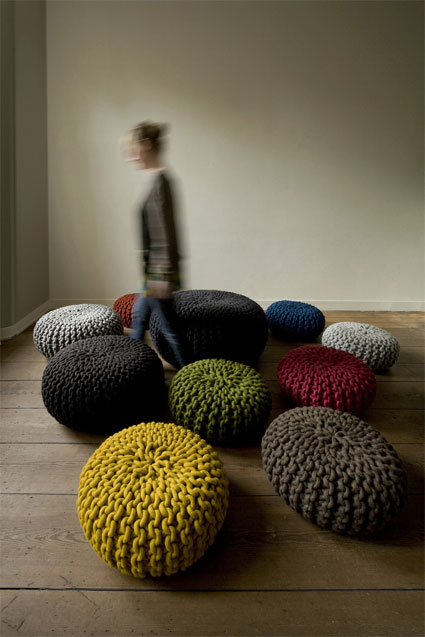 Image courtesy of the designer
Image courtesy of the designer
Any upcoming project you could share with us?
I recently did a project for The Nature Conservency. They invited me to make a design for the wool of an organic flock of sheep from Idaho. I visited the sheep that walk around in the wild all year long, it was an amazing experience. The project will be presented somewhere in spring next year in New York.
Thanks Christien!

